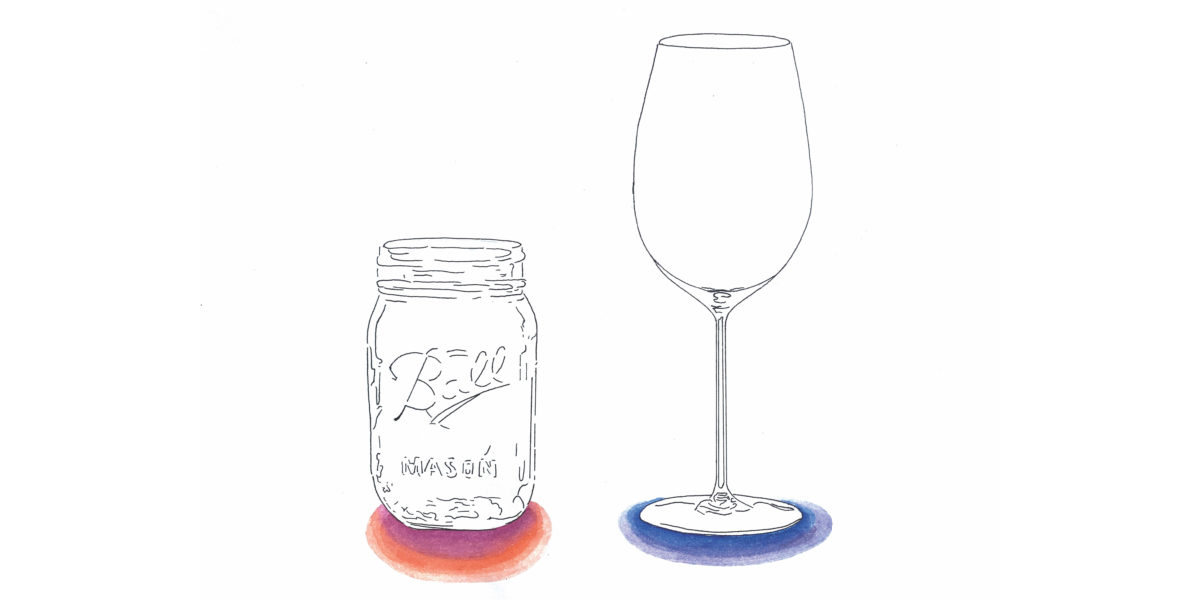
Do You Really Need Fancy Glasses to Drink Wine?
Are tumblers déclassé? Are delicate goblets elitist? Sunset editors debate this vital issue—which one has chosen wisely?

Hana Bae
Glassware is a polarizing topic in the wine world, with attitudes hewing to two common beliefs. In one, the finer the glass, the more elevated the experience. Why should fine wine be consumed in an inferior vessel?
In the other, a pedestrian glass holds liquids just the same as a German-engineered status flagon. It’s more practical, too—the tool of winemakers drawing barrel samples, European families enjoying table wine, and so on. Which path do you choose? Our editors duke it out. Which side are you on—the elevated (ahem, elitist) or the everyman (ahem, declassé).
The Elevated Imbiber
I’m a chronic glass breaker. It’s a slightly embarrassing symptom of wanting my wine to taste its very best—and the fact of the matter is the best wine glasses tend to be the most fragile. In lazy moments I’ve loaded the dishwasher with stems so thin they couldn’t survive the buffeting of water jets. I’ve cracked the bowl of crystal goblets trembling under the stress of a soapy sponge bath. And I’ve mortally wounded a glass or two during some exuberant moments at the dinner table.
I’m not typically the kind of guy who buys things that are bound to break, but decades ago I attended a seminar that opened my mind to the elevating effects of wine glasses specially designed to amplify the distinct characteristics of, say, Bordeaux made in the French style, a leaner white, or an old vine Zinfandel.
It turns out the size of the opening, the arc of the bowl, and the shape and thickness of the rim all affect how a wine’s bouquet is amplified or moderated and how the liquid makes contact with the tongue, tempering acid and tannin and highlighting fruit. I know it sounds pretentious, but if you’ve ever had the pleasure of drinking your favorite juice out of a Zalto wine glass so gossamer it seems to vibrate and bend under the weight of a pour and swirl, you know what I’m talking about.
Great glasses aren’t cheap, but you don’t need to buy a set of four if you can’t afford it. You can buy a single Zalto universal wine glass for around $60. It’s a lot, but it’s worth it to me to make a good wine taste great. Just go easy with the dish sponge. —Hugh Garvey, executive editor
The Everyman Pragmatist
There’s a scene in Indiana Jones and the Last Crusade when the ancient knight charged with guarding the fountain of youth asks both Indy and the requisite Nazi to choose a cup from a phalanx of resplendent serviceware. Long story short, the Nazi’s henchwoman chooses for him a gem-festooned chalice of gold, a baroque piece of drinkware that dazzles the fiend.
“It’s more beautiful than I could ever imagine,” he coos, and then promptly ages faster than an elder Kardashian bereft of plastic surgery after drinking from the fountain. As the Nazi disintegrates into dust, the knight deadpans: “He chose poorly.” Watching that scene warped my teenage brain but taught me a lesson. Indy wisely notes that Jesus was a carpenter, that he would have preferred a simple, well-made drinking vessel. He chooses the basic cup, takes a slug from the fountain, and the rest is history. And, well, sequels.
Point being: it’s what you bring to the experience that matters, not the artifice. Status glassware is compensatory; it’s fragile; it’s defiantly un-portable. Do I enjoy the thin rims, the delicate stems, the flagrantly elitist marketing? In varying measures. But give me a low, squat glass or even a jam jar like the one shown here and I’ll conjure up flavor connotations not even a floor-level Phish wookie could cough up at the encore. —Matt Bean, editor-in-chief
The Tiebreaker
We asked winemaker Scott Sampler to settle the debate, once and for all. As the head of the high-end cult winery The Central Coast Group Project as well as the ultra accessible natural wine brand Scotty-Boy!, he’s got a foot in both worlds. And… he didn’t exactly pick sides.
“Think of your glassware like speakers for the wine,” he said. “If you’re drinking a $100 wine, you might want that on your hi-fi system, the high end set-up with the vacuum tubes, on a premium turntable. But if you’re drinking an everyday wine, then maybe it’s okay to listen through your boom box.”
Essential Wine Gear
We only recommend things we love. If you buy something through our site, we might earn a commission.
This Story Came From the 2020 Wine Issue—Read It Here!
To read: Click on the right and left arrows at the edge of the box to turn pages; to make the text larger, click on the fullscreen icon in the lower-right corner (desktop) or in the center (mobile).
Get one year of Sunset—and all kinds of bonuses—for just $24.95. Subscribe now!
